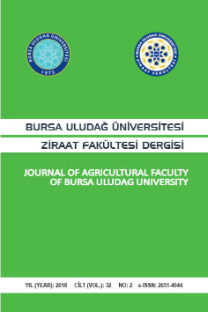Değişik zorlamalı tüy dökümü programlarının ticari yumurtacı tavuklarda başlıca verimler üzerine etkisi
Bu çalışma, değişik zorlamalı tüy dökümü programlarının ticari yumurtacı tavuklarda başlıca verimler üzerine etkisini belirlemek amacıyla yapılmıştır. Çalışmada ticari bir genotipten (Nick Brown) 86 haftalık yaşta 1093 adet tavuk kullanılmıştır.Tavuklar 1 kontrol ve 2 deneme grubuna ayrılmışlardır. Kontrol grubunda yer alan tavuklar deneme süresince ticari yumurta tavuğu yemi ile yemlenmişlerdir. I. deneme grubunda yer alanlar 10 gün tane arpa ile yemlenmiş, 11. günde ticari yumurta tavuğu yemine geçilmiştir. II. deneme grubuna 10 gün yem verilmemiş, 11. günden 28. güne kadar tane arpa ile yemleme yapılmış, 29. günde ticari yumurta yemine geçilmiştir. Bütün gruplarda deneme süresince su serbest bırakılmış, günde 16 saat aydınlatma uygulanmıştır. I. ve II. deneme gruplarında; tüy dökümü programının başlamasından % 50 yumurta verimine kadar geçen süre sırasıyla; 30 ve 43 gün bulunmuştur. Tavuk kümes yüzde yumurta verimi, tavuk başına tavuk-gün sayısal yumurta verimi, kırık-çatlak yumurta oranı ve ortalama yumurta ağırlığı bakımından gruplar arası farklılıklar istatistiki olarak önemli bulunmuştur (P
Anahtar Kelimeler:
yumurta tavuğu, üretim, kümes hayvanları, tüy dökümü
Effect of different force moulting programmes on main production parameters in commercial laying hens
In this study, 1093 hens from a commercial cross (Nick Brown), 86 weeks of age, were used to determine the effects of different force molting programmes on main production parameters in commercial laying hens.The hens were divided into 1 control and 2 treatment groups. The hens in the control group were fed throughout the experiment with commercial layer ration. Whereas the 1st treatment group was fed a whole-grain barley during the first 10 days and as from the 11st day up to the end of the experiment commercial layer ration were used as feed material. In the 2nd treatment group, during the first 10 days, hens were kept without any feed material. After that, hens consumed whole-grain barley until days 28. Then on day 29, hens were returned to commercial layer ration. Water was given freely and 16 hours lighting was maintained in all of the groups during the experiment. The period from the beginning of the molting programmes up to 50 % egg production was found as 30 and 43 days for the Ind and IInd treatment groups, respectively. Statistically, there was a significant difference among the groups for the hen-housed egg production, total hen-day egg production per hen, the cracked egg ratio and average egg weight (P<0.001, P<0.001, P<0.01, P<0.05). Induced molting process significantly increased feed conversion efficiency and decreased mortality compared to the control group.
Keywords:
hens, production, poultry, moulting,
___
- 1. AKSOY FT. Tavuk Yetiştiriciliği. 3. Baskı, s:67, Şahin Matbaası, Ankara, 1999.
- 2. AKSOY T, DUVENCIOĞLU H. ALTENLER S. SAVAS T. Erken yaşta tüy değiştirmeye zorlanan ticari yumurtacı bir sürüde yumurta niteliğine iliş kin bir araştırma. Türk Veterinerlik ve Hayvancılık Dergisi. 1997, 21:2, 141-146.
- 3. ALODAN MA, MASHALY MM. Effect of induced molting in laying hens on production and immune parameters. Poultry Science. 1999, 78:2, 171-177.
- 4. BELL D. Ten versus fouteen day fasting with and without molt feed. Poultry adviser. 1991, 24.12, 59-61.
- 5. BELL D, KUNEY DR. Effect of fasting and post fast diets on performance in molted flocks. Applied Poultry Research. 1992, 1:2, 200-2062).
- 6. ERENSAYIN C. Bilimsel-Teknik-Pratik Tavukçu luk. Cilt II, s:431-461, TDFO, Ankara, 1992.
- 7. GARCIA EA, MENDES AA, PINTO, MCL, GARCIA SCR. Evaluation of physcical parameters in semiheavy laying hens subjected to forced moulting. Beast CD 1989-2000 (Veterinaria e Zootecnia, 1996, 8:65-73).
- 8. HURWITZ S, WAX E, NISENBAUM Y, BEN- MOSHE M, PLAVNIK I. The response of laying hens to induced molt as affected by strain and age. Poultry Science. 1998, 77: 1, 22-31.
- 9. IBRAHIM MA. Induced moulting : Part I. Poultry International. 1998, 37:4, 28-29.
- 10. JUNQUEIRA OM, CUSTADIO RWS, CARVALHO NP, ARIKI J. Effects of limited lighting and restricted feeding on the resumption of laying after forced moulting. Beast CD 1973-1988 (Cientifica. 1979, 7:119-122).
- 11. Mc DANIEL BA, ASKE DR. Egg prices, feed costs and the decision to molt. Poultry Science. 2000, 79:9, 1241-1245.
- 12. NORTH MO, BELL DD. Commercial Chicken Production Manual. Fourth Edition. Chapman & Hall, New York, London, 1990.
- 13. OHTSUKA S. Effects of limited lighting and restricted feeding on the resumption of laying after forced moulting. Japanese Poultry Science. 1986, 23:6, 334-343.
- 14. ÖĞÜN S, AKSOY T. Değişik tüy değiştirme yön temlerinin ikinci verim yılında yumurta verimi ve kalitesine etkileri. Doğa Türk Veterinerlik ve Hay vancılık Dergisi. 1991, 15:3, 338-348.
- 15. RAMORAO SV, RAJU MVLN, PRAHARAJ NK, REDDY MR. Induced Moulting: Part II- Biochemical Methods. Poultry International. 1998, 37:5, 34-37.
- 16. ROBİNSON D, WILSON GC, BARRAM KM. Multiple short cycles-an alternative management schedule for laying flocks. Beast DC 1989-2000 (Proceedings, 19th World’s Poultry Congress, Amsterdam, Netherlands, September 1992, 2:475- 479, 20-24).
- 17. SÜMBÜLÜOĞLU K, SÜMBÜLÜOĞLU, V. Biyoistatistik. 5. Baskı, Özdemir Yayıncılık ,1995.
- 18. ŞENKÖYLÜ N. Modern Tavuk Üretimi. 2. Baskı, s:247-250, Anadolu Matbaa ve Tic., İstanbul, 1995.
- 19. ZUMBADO AME, SOLİS SJ, URENA G. Force molting of laying hens housed in littered floor. Results of field studies. Beast CD 1989-2000 (Nutrition Animal Tropical, 1998, 4:1, 79-100).
- ISSN: 1301-3173
- Yayın Aralığı: Yılda 2 Sayı
- Başlangıç: 1981
- Yayıncı: Ahmet Akkoç
Sayıdaki Diğer Makaleler
Bursa ortak girişim tesislerinde (Etba) kesilen koyunlarda distomatozis'in yayılışı
Bursa' da tüketilen bazı sebzelerde nitrat ve nitrit
H. Hüseyin ORUÇ, Selahattin CEYLAN
Berrin ZIK, Hakan BİRİCİK, Nesrin ÖZFİLİZ, Korhan ALTUNBAŞ
HAKAN BİRİCİK, İ.İsmet TÜRKMEN
HÜSEYİN YILDIZ, BAHRİ YILDIZ, ALİ BAHADIR, Ayşe SERBEST, Gülsüm ÖZYİĞİT
Koyunlarda metabolizma kafesinde tutulmanın bazı fizyolojik parametreler üzerine etkileri
Fahrünisa CENGİZ, Murat YALÇIN
Fare colliculus inferior sinir hücreleri üzerine asotilkolinin etkileri
Bir köpekte immun ilişkili hemolitik anemi ve trombositopenin vineristine ile tedavisi
